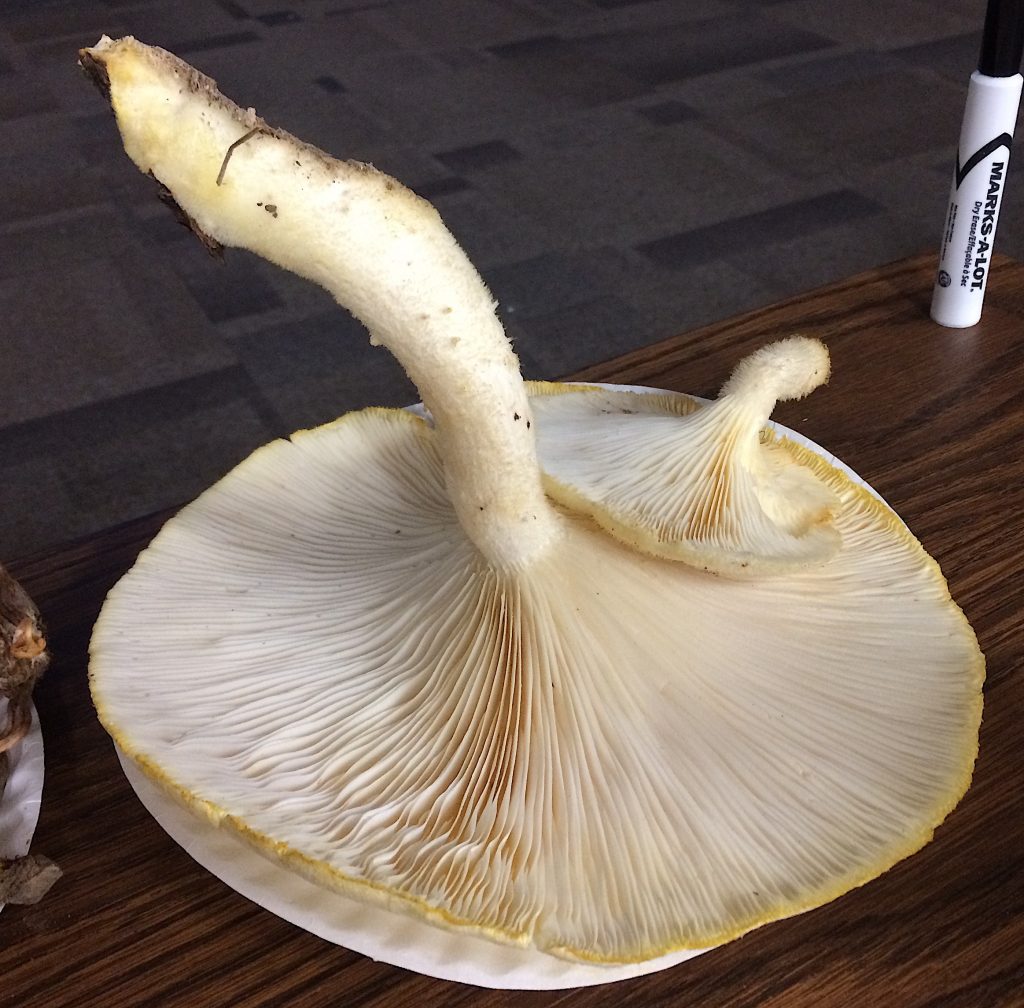
Not a small mushroom, recently moved into the Oyster genus. Photo by Green Deane
Still unpacking from my road trip (which is my excuse for this shorter-than-usual weekly newsletter.)
Over the weekend I attended a two-day mushroom class in Ashville, North Carolina. While the purpose of the class is to be certified so one can sell (or in some locations) harvest wild mushrooms it’s also a good two-day class in edible mushrooms. As some of you may know I’ve incorporated mushrooms into my foraging classes and started several mushroom pages on Facebook. They are the Orlando Mushroom Group, Florida Mushroom Identification Forum, Southeastern U.S. Mushroom Identification, Edible Mushrooms: Florida and Edible Wild Mushrooms (that latter I have yet to populate. If you want to join that and post there let me know.) The pages have thousands of members.

Where I stayed had pet pigs. This is Darryl cleaning up green acorns.
When it comes to wild plants as a forager I am interested in edible plants and medicinal plants to some extent. I was not allowed to take chemistry in school and I find that bothers me some or at least I wish I knew more. And of course I have an interest in avoiding toxic plants. I am not interested in the whole wide world of plants, or perhaps better said, there is only some much time so specializing works for me. Likewise I fall into the same category with mushrooms: I am interested in the edible ones, some of the medicinal ones and of course avoiding the toxic ones. Surprisingly that view can generate derision among fungal fan: You have to love them all or you’re spreading “fungiphobia.” As the purpose of this class by Tradd Cotter was edible mushrooms it was nice to spend two days discussing and studying edible fungi without a discouraging word. We studied Oysters, Honey, Milkies, Hen of the Woods, Chicken of the Woods, Lobsters, Lion’s Maine, Puffballs, Chanterelles and a few more. Got to handled more than two dozen species up close and personal.
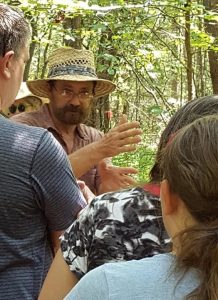
Talking about Willows during the class at Putney Farm, Honea Path, S.C.
After that was an experiment: Should I hold foraging class in the Carolinas? (And for that matter the Florida panhandle which is about as far.) It requires a trip of several days, a place or two to stay, and a suitable location. For this first foray my cousin Lenard Putney and his wife Donna let me hold an event at their farm in Honea Path, S.C. It worked out well. Though the class was held on a Monday it attracted some three dozen people plus an assortment of kids. We didn’t get a chance to look at all the edible species, about six dozen, but that is what later classes could cover. I don’t know about more classes there this year though the weather holds well there. But probably next year they can be arranged, and on a weekend. We’ll need to sort out some details. And if you know of possible locations please let me know.

Classes are held rain or shine or cold but not hurricanes.
September foraging classes: All classes are at least three hours long and usually involve one to two miles of walking over that time period. It’s a saunter. We explore the area and find edible and medicinal plants and some mushrooms. This weekend I have a class by request in Ocala and one in Sarasota. Both nice locations.
Saturday, September 1st, Jervey Gantt Recreation Complex, 2390 SE 36th Ave., Ocala, FL, 34471. Meet at the entrance to the pool, aka Aquatic Fun Center. 9 a.m.
Sunday, September 2nd, Red Bug Slough Preserve, 5200 Beneva Road, Sarasota, FL, 34233. 9 a.m.
Saturday, September 8th, Blanchard Park, 10501 Jay Blanchard Trail, Orlando, FL 32817. 9 a.m. Meet at the pavilion east of the tennis courts near the YMCA.
Note: The afternoon of Sept. 8th there is a Mushroom Class just west of Sanford Fl. For more information go to the Orlando Mushroom Group on Facebook.
Sunday, September 9th, Bayshore Live Oak Park, Bayshore Drive. Port Charlotte. Meet at the parking lot at the intersection of Bayshore Road and Ganyard Street. 9 a.m
Saturday, September 15th, Colby-Alderman Park: 1099 Massachusetts Street, Cassadaga. Fla. 32706. 9 a.m.
Sunday, September 16th, Eagle Park Lake, 1800 Keene Road, Largo, FL33771. 9 a.m. Meet at the pavilion near the dog park.
Sunday, September 23rd, Dreher Park, 1200 Southern Blvd., West Palm Beach, 33405. 9 a.m. Meet just north of the science center.
To learn more about the classes and or to pay for one go here.
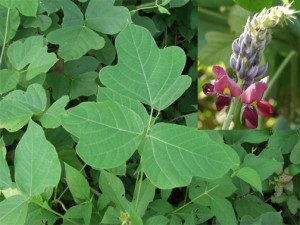
Kudzu leaves actually make good pesto.
While visiting the Carolinas this week I saw the plant that is commonly known to have smothered The South. It leaves the impression that if you fell asleep in a lawn chair at noon by supper time you would be covered by Kudzu. Driving or hiking through places like North or South Carolina one can see steep hillsides thickly blanked with the large, herbaceous vine. But it is the botanical beast what it’s purported to be? Important to us is that nearly the entire plant is edible: Leaves, growing tips, grape-scented blossoms, young roots and older root starch. Only the seeds are not edible by humans. However the plant does support wild life and domestically goats are particularly fond of it. Turning Kudzu into goat products is profitable, tasty and sustainable. While Kudzu can be a local problem its invasiveness has been exaggerated by regional writers.
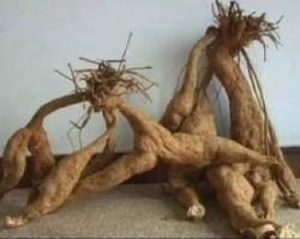
While the roots do have edible starch it is difficult to extract by hand.
Kudzu was first championed during the Dust Bowl Era because it was the prime plant for fighting erosion. Folks were paid to sow it on their land (no complaining then.) About a million acres were planted over the next 20 years then the program ended. Kudzu meanwhile had worked its way into southern novels and folksy observations. It became a southern cliche. In reality Kudzu occupies about one tenth of one percent of the South’s 200 million acres of forest, or 227,000 acres. Asian Privet, which is rarely commented on by anyone, occupies some 3.2 million acres, 14 times that of Kudzu. Kudzu is spreading but at one thousandth-something rate of of the Asian Privet, around 2,500 acres a year. And in time Kudzu might be significantly reduced: Seven years ago a Japanese Kudzu bug was found in a garden in Atlanta (a city which is six times the size of the Kudzu infestation.) The bug was a stowaway on some plane. It is now successfully devouring Kudzu. In one test site the bug ate a third of the Kudzu in two years. In decades to come Kudzu might be but a bucolic memory, a quaint reference to how it used to be. To read more about Kudzu, go here.
I am often asked why forage. There are many answers. One is wild plants have different flavors and nutrition, usually more powerful than their cultivated relatives. In the case of one medicine you can save money… a lot of money.
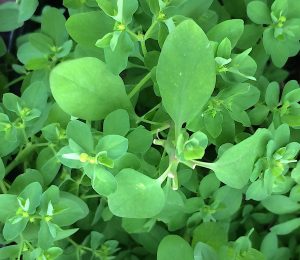
Radium Weed. Photo by Green Deane
Euphorbia peplus, or Radium Weed, is a species originally from Europe. It went with new world colonists and thus got to places like Australia. There it is classified as a noxious weed but much used for treating skin cancer such as basal cell, squamous cell and intraepidermal carcinomas. Radium Weed is reported sporadically in the United States such as in one county in each of these states: Louisiana, Tennessee, North Carolina, Kentucky, Colorado, and Illinois. It’s more common in some states and regionally such as in Southern California. The seeds are inexpensive to buy over the Internet. The white sap of the plant is put on skin lesions daily for three days and according to research is as effected as other nonsurgical intervention. In fact in the March 2011 edition of the British Journal of Dermatology it was reported that in a study using 36 patients “the sap from Euphorbia peplus is effective against human nonmelanoma skin cancers.” The active ingredient was identified as Ingenol Mebutate. That’s also the main active ingredient in a pharmaceutically prepared cream for the same use called Picato Gel, about 98% plus 2% gel. There is some controversy.
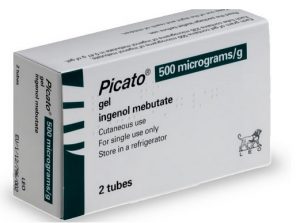
Picato Gel
The FDA warned in 2015 that Picato Gel can have serious side effects such as allergic reactions and shingles. More common, though, are people applying it, getting some on their fingers then touching their eyes. People who did not wash their hands thoroughly later had issues when applying makeup or inserting contact lenses. I could not find any follow up on the 2015 report of shingles being related to the medication’s use. That might have have been a coincidence. As to why folks would use the sap directly from the plant rather than buy the preparation which is almost identical: Depending upon the amount of Ingenol Mebutate in the preparation a package of two tiny tubes costs from about $700 to $1,200 per prescription. Perhaps the lesson is the plant is powerful medicine and needs to be used carefully… and we should also question why six drops of sap from a plant that is very easy to grow costs $1,200.

Green Deane DVD set of 135 videos
All of Green Deane’s videosavailable for free on You Tube. They do have ads on them so every time you watch a Green Deane video I get a quarter of one cent. Four views, one cent. Not exactly a large money-maker but it helps pays for this newsletter. If you want to see the videos without ads and some in slightly better quality you can order the DVD set. It is nine DVDs with 15 videos on each for a total of 135 videos. Many people want their own copy of the videos or they have a slow service and its easier to order then to watch them on-line. The DVDs make a good gift for that forager you know especially on long, cold winter months. Individual DVDs can also be ordered or you can pick and choose. You can order them by clicking on the button on the top right hand side of this page (if your window is open wide enough.) Or you can go here.
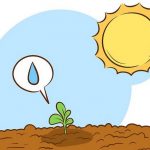 Donations to upgrade EatTheWeeds.com and fund a book have gone well and made it past the half way mark. Thank you to all who have contributed to either via the Go Fund Me link, the PayPal donation link or by writing to Green Deane POB 941793 Maitland FL, 32794. The goal now is to expand the forum page and the means to display more foraging teachers.
Donations to upgrade EatTheWeeds.com and fund a book have gone well and made it past the half way mark. Thank you to all who have contributed to either via the Go Fund Me link, the PayPal donation link or by writing to Green Deane POB 941793 Maitland FL, 32794. The goal now is to expand the forum page and the means to display more foraging teachers.

Green Deane Forum
Want to identify a plant? Need to identify a plant? Looking for a foraging reference? Maybe you have a UFO, an Unidentified Flowering Object, you want identified. On the Green Deane Forum we — including Green Deane — chat about foraging all year. And it’s not just about warm-weather plants or just North American flora. Many nations share common weeds so there’s a lot to talk about. There’s also more than weeds. The reference section has information for foraging around the world. There are articles on food preservation, and forgotten skills from making bows to fermenting food. Topics have included: Tea, Salt and Amla, Small Bush and Flower, Ragweed? Pine Cough Drops and Needles, Odd Vine? Hunting and Trapping Ethics. Knife Accidents. Some Kind of Lespendeza and Survival Garden. You can join the forum by clicking on the button in the menu line.
This is weekly issue 319.
If you would like to donate to Eat The Weeds please click here. Or you can use my Go Fund Me link, or by writing to Green Deane POB 941793 Maitland FL, 32794


Hey dean,
fan and several time student of yours. you should definitely do some distance classes!! i have access and places to put you up in a few different locations if your interested. in North carolina close to raleigh, arkansas/missouri area, Embden maine, i have a few friends on the panhandle side and also some friends with land not to far about an hour from atlanta where i think you could get pretty busy. ive noticed the forum grow and grow from different areas there is certainly interest. im linked up with this deal called flint and steel critical group which is kind of like uber for vetted survival instructors and ive told them all about you cause i think youre top notch im sure many of us would love to put you up and share some land for you to teach on.
i know you were asking about the carolinas and the panhandle for next year schedule but just letting you know i might be able to help with that and offer you other areas too. you put out great info and id love to help you do that for even more people if i can
id also like info on joining some of your mushroom pages. i had a mushroom mentor a few years ago who was pretty good, but i had been told that all coral mushrooms were good to go, first book i picked up proved that wrong and kind of tarnished the whole deal for me. anyhow super excited your considering branching out best of luck
Thanks for the add Deane!